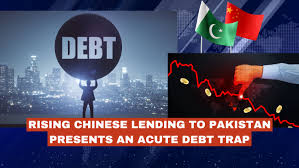
Pakistan’s federal government will present the budget for the financial year (FY) 2024-25 in the National Assembly on 12 June 2024. The date June 28 has been set for concluding discussion and approval of the Budget-2024-25
Pakistan’s FY 2023–24 growth rate is hardly 3%, the lowest ever in 77 years since independence. The fiscal deficit between income and expenditure in FY 2023–24 is one of the highest fiscal deficits, i.e., 6%–7% of GDP.
Pakistan’s total domestic and external debt stock rose by 8.6 percent during the first 10 months of this fiscal year (FY24)
Cumulatively, the central government’s total domestic and external debt stock reached Rs 66.083 trillion at the end of April 2024 compared to Rs 60.841 trillion in June 2023, depicting an increase of Rs 5.242 trillion.
The Finance Division has set the dollar value at Rs 295 for the upcoming fiscal year budget, indicating Rs 10 per dollar depreciation in the local currency, as a result the business community is likely to experience additional depreciation in the currency. Unless a significant amount is credited before the State Bank of Pakistan or the dollar price is capped, further depreciation is inevitable due to scheduled debt payments.
The cycle of sovereign debt stress Pakistan is experiencing is not new, it has been a recurring feature of its economy for decades. Pakistan has been paying more in debt repayments for the past twenty years than it receives and yet in that the amount owing has grown 200%.
The current economic situation of Pakistan and the future agenda of the Government indicates that Pakistan has fallen into a debt trap. Public revenue is being spent to pay high interest rates on its foreign loans, leaving no money for public investment in infrastructure and services. As the currency continues to depreciate, the real cost of its debt goes up, credit agencies reduce its ratings and interest rates continue to skyrocket.
Pakistan’s total budget for 2022–23 was estimated at PKR 9,579 billion, of which PKR 1,052.2 billion was allocated for development. In 2021–22, Pakistan had a ranking of 161 on the Human Development Index (HDI). The country was categorized as having “low HDI”.
- Village Rhapsody: How Zimbabwe can improve governance
- Defaulting Zim in bid to pacify Paris Club . . .US$420.4m black hole exposed
- Fidelity loans, IMF windfall to give Zim mines a big lift
- I am not scared: AfDb chief shrugs off Africa food crisis
Keep Reading
The country’s debt and liabilities have risen steeply to nearly ninety percent of the size of the economy. Yet the Government has indicated interest in taking on more loans, particularly from the International Monetary Fund (IMF) and friendly countries. However, an increased level of external debt can pose a great risk to the fiscal framework of an economy when the current account deficit is high, foreign reserves are at low levels, and the exchange rate is under pressure.
Debt servicing has become an acute problem for Pakistan. In the last 20 years, Pakistan has not only paid external creditors more than it has received from them, the shift in the lending programmes of international financial institutions has resulted in Pakistan’s consumption loans increasing from 7.7 percent in 1990 to 70 percent in the 2000s.
China’s lending to Pakistan has increased from 9.3 percent of Pakistan’s external debt in 2013 to US$ 28.4 billion. Last November a study revealed that two decades of Chinese lending to Pakistan totaled about $21 billion more than previously thought. AidData, a research institute at William and Mary University in the U.S., calculated Pakistan’s cumulative public debt exposure to China at $67.2 billion for the period from 2000 to 2021. That surpasses the $46 billion recorded for the same period in the World Bank’s International Debt Statistics, based on voluntary disclosures from Pakistan.
China’s loans to Pakistan often enter the front door as short-term debts with maturities of 12 months or less, but exit the back door as long-term debts. China subjects Pakistan to a 7.1% interest rate, determined by the six-month Secured Overnight Finance Rate (SOFR) plus an additional 1.715%.
The first goal in development strategy as regards to the taxation policy. Performance of the Pakistani tax managers on this account is highly disappointing, with fiscal deficit remaining high during the last many decades and despite revenue targets fixed annually and subjected to downward revision many a times, yet remained un-achieved.
Amidst this bleak economic situation, concluding his five-day official visit to China from June 4-8 Prime Minister Shehbaz Sharif expressed confidence in Pakistan and China’s commitment to carrying out the eight major steps for supporting high-quality Belt and Road cooperation, forging an “upgraded version” of China-Pakistan Economic Corridor (CPEC) by jointly building a growth corridor, a livelihood-enhancing corridor, an innovation corridor, a green corridor and an open corridor.
Sharif’s visit to China comes as the latter’s loan (US$ 100 billion) matures this year. The fact remains that CPEC projects have only exacerbated weakness in Pakistan’s governance and contributed to the already unsustainable debt load of the country.
The current IMF bailout has laid down several conditions on the Pakistani Government, including taxes and subsidies, government spending, interest rates, and the foreign exchange rate . The most stringent condition is to account in detail Chinese financial outlay through the China–Pakistan Economic Corridor (CPEC) and provide firm assurances that Pakistan will not divert IMF loans to service its China debts.
Last month the IMF Staff Mission held a series of meetings in Pakistan on the next Fund Programme in the form of an Extended Fund Facility (EFF) for the next three years.The IMF is testing if the present political dispensation is willing to implement the tough budgetary reform agenda for 2024-25, before a move is made to finalise the three-year EFF.
Washington has reportedly decided to dispatch a Treasury Department delegation to Pakistan to evaluate Islamabad’s economic situation, prospects of IMF’s new program, and general business and investment climate. The debt taken by Pakistan from the IMF has increased in rupee terms due to currency devaluation. Hence, in the long run, the IMF loan has the potential to harm Pakistan and its economy, so unless Pakistan is able to implement wide-ranging reforms on multiple fronts to establish credibility as a borrower with the ability to repay by achieving a sustainable external balance of payments and budgetary position.
The reform agenda will also include other strong measures like privatization and scaling down of losses of State-Owned Enterprises, transfer by the Federal government of functions and projects to the Provincial governments along with the expenditure liabilities, pension reforms, etc. The year, 2024-25, will truly have to be a year of major reforms.
A significant portion — $28.4 billion — of Pakistan’s loans from China are in the energy sector, and as Islamabad struggles to pay off these loans, the fundamental question to be asked is : Will the underlying issues regarding Pakistan’s macroeconomic and fiscal situation be addressed by the current government, or will Pakistan continue to inch towards a financial default?






